
Once, on a Christmas Eve in Hicksville, a tail light ignited a street fight between village residents and New York State Troopers. At its climax, the Troopers were backed against a wall by a crowd of 40 men, some of them armed, and many of them likely half-drunk. By the time the ruckus was over, several Hicksvillians had been arrested for their part in the riot. During the subsequent arraignment (at which guns once again were drawn) there was talk of charging some of the villagers with sedition. After all, this was 1917, and unpatriotic remarks uttered in time of war could not be tolerated.
Curiously, those arrested were among the leading citizens of the village. One was a dental surgeon; others were Special Reserve Sheriff's Deputies. Even more remarkable was the identity of the man charged with instigating the riot: William J. Duffy, past President of the Board of Education, respected member of Nassau's Democratic Party, and Chief of the Fire Department. He would later serve as President of the Long Island National Bank.

For men such as these to have rioted seems unfathomable; there must be more to the story. Let's begin by looking at what else had happened in Hicksville that year.
***
Hicksville's 1917
Multiple things conspired to make people in Hicksville edgy that December. There were two major factors, both of which had first arisen eight months earlier. One was the United States' participation in World War I; the other was New York State's new mounted police force. These two phenomena set the stage for the riot - but there also was something else at work: two of the key characters in the developing drama had a personal history.
Being German
By now, over-zealous excitement about America's entry into the war had faded, and people were worrying. Family members were in uniform, and soon they would be in harm's way. Troop trains rolled through Hicksville, each carrying a thousand men - draftees to, or brand-new soldiers from, Camp Upton. The war's continuing carnage made the future of young men like these less certain every day.
According to the White House, America's entry into the war had been reluctant. Regardless of whether or not that was true, the country's sympathies had been clear for a long time. During its three years of official neutrality, America had openly paraded - sometimes literally, as illustrated by the flags in this 1916 painting of Manhattan's Fifth Avenue - its feelings, which lay not with Austria-Hungary and Germany, but instead with France and the British Empire.
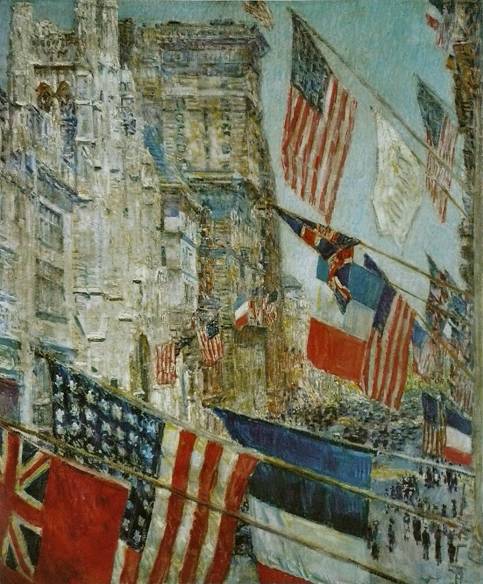
Childe Hassam, Preparedness Day Parade, 1916
http://vexillophilia.blogspot.com/2010/05/childe-hassams-flag-paintings.html
One of the explanations that historians give for the earlier neutrality is the Wilson administration's concerns about the reactions of American citizens of German descent. On that score, Hicksville ranked higher than most places; during the 19th century, its Quaker roots had receded before an influx of German farmers and businessmen. In 1917, the notable residents mentioned most often in the local press had names like Huettner, Herzog, Kroemer, Puvogel, Steinert, Wetterauer, or Braun. Many of the clerics in the village were German, and not just the Lutheran ones; Fathers Goetz and Fuchs were early priests at St. Ignatius. Most of the owners of the village's hotels, where people socialized each evening and exchanged news, were German-Americans, like Messrs. Reinhardt, Wolgast, Fleischbein, and Vogel. The hotels' décor was often German-themed, as were the menus; hasenpfeffer was a specialty. Despite the preponderance of German ancestry, Hicksville rallied behind the nation's decision to join in the war.
It must have been hard, however, for many of its citizens to stomach the propaganda campaign that soon flooded the country. Some of the village's German immigrants, like the venerable Herman Menge, had served with the Union Army during the Civil War. Now, the descendants of their fellow soldiers were doing their best to vilify and insult all things German - sometimes, all things "foreign" - making life painful for anyone who was German-American.
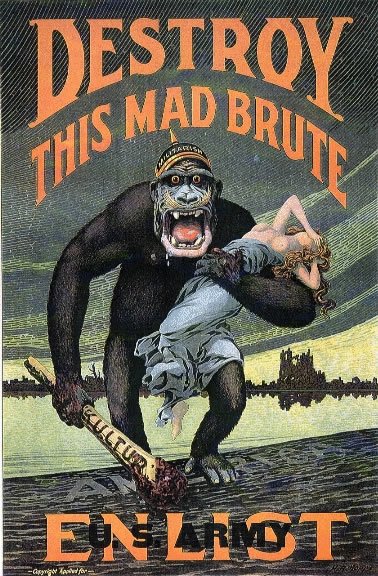
U.S. Army Recruiting Poster
Library of Congress, www.loc.gov/pictures/item/2010652057/
For example, this poster (pre King Kong, incidentally) depicts Germany as a gorilla, standing on the word America as he wades ashore, having already found a young American woman to molest. Note that his bloodied club bears the word Kultur. This probably is a reference to Prussia's one-time (but by 1917 long abandoned) Kulturkampf policy, devised to drive people of "undesirable" ethnicities from the then-Prussian lands in which their ancestors had lived.
Note that when the story of the Hicksville rioters appeared in the New York Tribune, these news items could be found on the same page:
The American Defense Society was lobbying New York City to cease teaching German to its language students, because doing so posed "a serious threat to the city."
- The New York branch of the National German-American Alliance resolved to fight the attempts to end public school instruction in all foreign languages, saying that German-Americans were stronger than all the "narrow minded people who are behind the obnoxious propaganda...."
- An aeronautical engineer at Wright Aircraft with a German name had been arrested on suspicions of draft-dodging and espionage.
- Germany was suspected of having "ordered" the International Workers of the World to sabotage American grain silos in order to weaken America- even though the IWW tended to be socialist or communist, and was not a likely ally of Germany.
The country was polarized. German-Americans felt persecuted, and too many other Americans seemed willing to persecute them.
***
Advent of the State Police
In the years leading up to 1917, Albany had become persuaded - ironically, because of a high-visibility crime in Westchester - that the state's rural counties and towns were not providing adequate policing, especially to those who lived in growing communities.
Had policing been deficient in Hicksville? Not by the prevailing local standards. The village had hired its own constables; if needed, it could call upon the Town's local Reserve Deputies; its Court House did not seem overly neglected. Local newspapers suggested that the police had the habit of overlooking unlicensed dogs, and children riding horseback in town after dark, but these were offenses about which few villagers cared. The local constabulary also rarely enforced the state-imposed 11:00 PM curfew for establishments that served liquor - a failure which many people in Hicksville happily applauded.

Some of the first New York State Police Troopers
https://centennial.troopers.ny.gov/photos/fairs-over-the-past-100-years-in-troop-a
Regardless of whether communities in New York liked or disliked the idea of getting an additional layer of policing in their streets, as soon as the new police (called "Troopers" by their founder) were fully trained, 232 mounted officers were deployed in rural areas across the state. New York was divided into State Police regions; within each region were multiple detachments. Although Nassau County announced that the local detachment eventually would be based in Mineola, it first was housed at Hicksville's Grand Central Hotel.
In some - in many - communities, the Troopers were resented by local law enforcement. Rumors were circulated, most of them likely false; some depicted the new police as arrogant. It did not help that the Troopers had been ordered to wear their holstered firearms outside their uniform - a practice almost unheard of then, and one which suggested swagger to the average citizen. Locals were told that "the Troopers had been kicked out" of the village of Glen Cove (not true), and that Hicksville should do the same. Citizens' trust in the State Police was not bolstered when a Mineola physician testified in court that while he was driving home one night, a Trooper shot at his tires - to stop him because his car's tail light was not lit.
Troopers and the townspeople were at odds at the beginning, and everyone admitted it. The official online State Police history notes that
"One of the earliest challenges facing the Troopers was to overcome the natural suspicions of the rural population they were sent out to protect. Many rural newspapers voiced the common belief that the force was unneeded and an unnecessary expense."
https://www.troopers.ny.gov/Introduction/History/1917-1929/
The Brooklyn Daily Eagle wrote that the riot in Hicksville was indicative of feelings in much of the County:

Thus, Hicksville had a second reason to be polarized. Suspicion and resentment were near the surface of any confrontation between State Troopers (and their supporters) and those citizens who favored the old status quo.
***
Personalities
It seems unlikely that William Duffy would normally have been very upset to receive a summons for an unlit tail lamp. In this case, however, he was rankled, because the summons had been issued in Hicksville. That meant he would have to appear before the bench of widely-respected Justice Joseph Steinert. (Note that more information about Justice Steinert appeared in September's Ancient Hixtory, which is still available at 1809/hixtory.htm)
By several accounts, the men disdained each other. A letter published in the Long Islander, sympathetic to those who had been arrested, spoke of "the long-standing political enmity between Justice Steinert and Mr. Duffy." Steinert was an established leader of the Town of Oyster Bay's Democratic Party, but a bloc of younger Democrats viewed him as part of the Town's "old guard." Duffy had publicly criticized him in the past, hoping to stir the village's Democrats into seeking new leadership. Now he probably expected Steinert to take pleasure in watching him sweat in court.
Mutual mistrust may also have arisen because of the two men's different origins. Both had worked hard to attain positions of esteem in Hicksville, but compared to Duffy's origins in a farming family, Steinert had something of a head start. He was born into a family of lawyers, and he had arrived in Hicksville possessed of both a good education and useful connections. Duffy's being much younger would have amplified their differences; it seems likely that the Judge would have seemed condescending when dealing with the Fire Chief.
How did Duffy get to be a prominent citizen of Hicksville? He had been born late in 1882, the son of Henry Orth, a German immigrant, and Margaret Duffy, the daughter of an Irish family who farmed land situated along what people already were calling "Duffy's Lane." For reasons unknown to me, the 1900 U.S. Census does not list Mr. and Mrs. Orth as residing in Hicksville. It does, however, show their son, listed as farm laborer William Orth, living on the farm of his widowed grandmother, Catherine Duffy. At some point between that census and 1905, he had his name changed legally to William John Duffy.
Among his earliest impacts upon Hicksville was the transformation of well-used but decrepit Duffy's Lane into a proper public thoroughfare. By 1905, after decades of neglect - either the Town had been derelict in its duties, or perhaps it had never realized the lane was not private property - not everyone agreed on where the boundaries were between the lane and the adjoining farms.

Huntington Long Islander, October 7, 1902
Beginning that year, Duffy worked with the Town Board to resolve the disputed boundaries, and to get landowners along the lane to agree on its becoming a public road, one which would be supported by the TOBAY Highway Department. In May 1908, the Town accepted responsibility for maintaining the road, and the village powers agreed that the road should be renamed Duffy Avenue, in honor of the man who had worked for more than three years to effect the change. William J. Duffy was not yet finished, however. He then began working to get street lights installed along the full length of the avenue, ensuring that the light nearest his own property was installed last, after those near all his neighbors' properties.
More public achievements soon followed. Still a farmer, he was elected to the Board of Education, and for a time served as its President. He became Fire Chief. He served as a member of the Nassau County Farm Bureau, on the Hicksville Board of Trade, and he became increasingly active in the Town of Oyster Bay's Democratic Party.
***
What Happened, and Then What Happened
Accounts of the incident on Christmas Eve differ substantially; some of the reported allegations and quotations simply are not credible. I find it impossible to offer a definitive version of events - for instance, some reports say that the Troopers were on horseback, and others say that they were "back on their heels." The following paragraphs try to stitch together pieces of several conflicting versions, plugging holes as necessary, to create a coherent narrative. Doubtless, some of it remains inaccurate.
Early on Monday evening, December 24th, men began to gather in the saloon at Frank Reinhardt's Broadway Hotel, on the southeast corner of Broadway and The Broadway was the preferred meeting venue and tavern for the Fire Department, and for local members of the County Democratic Party. William Duffy's presence would have been a given - not only was he Fire Chief, but he also was trying to advance his position among Town Democrats.
By 7:00 PM, there were about 35 men in the saloon. A Trooper, patrolling Hicksville's streets with a partner, entered the room to ask about a car that was parked outside. William Duffy said it was his, and he was told it needed to have its lights lit. (Apparently, in 1917 lights had to remain lit when a vehicle was parked at night on a public street; this seems to have been among the regulations that local police had not enforced.) Duffy went outside with the Trooper and lighted the vehicle's lights. One report states there was an irritated exchange between the two at this point; when he asked Duffy to identify himself, the Trooper was told to use the license plate number to find out whose car it was. Duffy then went back inside. About 90 minutes later, the Troopers returned, this time to report that the tail light on Duffy's car was out. (One assumes that the tail light - in 1917, likely one that burned kerosene - had been lit during the earlier encounter between the men, as there had been no dispute about it then.) Duffy probably felt harassed. Outside again, he and the Troopers exchanged words. Things escalated when a Trooper attempted to issue him a summons; other men, likely "full of holiday cheer," had come out to watch, and a fight broke out.
One does not need an excess of imagination to understand the confrontation in the context of wartime America. Most of the men involved had German blood, and were celebrating the holiday as they always had, at a German-American hotel. Duffy himself was half-German. They likely felt persecuted - because of a tail light, and on Christmas Eve, for Heaven's sake! They were growing tired of the helplessness with which this new anti-German persecution burdened them.
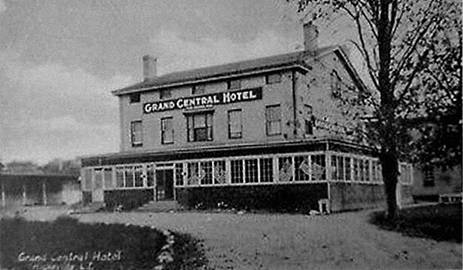

Grand Central Hotel
ebay.com; a better copy of this picture is found in Richard and Anne Evers' book 'Hicksville' in the Images of America series
William J. Duffy
Huntington Long Islander
For their part, the Troopers also felt persecuted, for they were constantly greeted with suspicion. Moreover, the laws that the local police left for them to enforce were primarily ones which annoyed the public they were trying to serve, making confrontations with the public more likely.
As the crowd grew in size and belligerence, the Troopers slowly retreated northward along Broadway, towards their temporary barracks at the Grand Central. Mob-like, the crowd moved with them, its size fluctuating. Reaching the hotel, about 40 men backed the Troopers against a wall. One of them drew a gun, and a few in the crowd shouted about lynching or shooting the besieged Troopers. The latter called up to the hotel's windows, trying to get help from the other Troopers billeted in the rooms. Two Troopers soon emerged and joined in the fray. Fearing that more might do so, the crowd began to disperse. Things finally quieted down at 2:00 AM.
***
Tuesday, Christmas Day, was deceptively quiet. Unknown to the residents of the village, the local Troopers had communicated with their State Headquarters, and their Captain was en route from Albany for the next day's appearance in Hicksville's Court House.
Wednesday morning, State Police swore out warrants before Judge Steinert. There were multiple charges, including inciting a riot, resisting arrest, and assaulting an officer who was discharging his duty. The six men facing charges were Herman Ofenloch, Osborn Curtis, Charles Van Wickler, Adolph Lauck, William Duffy, and Christian Brengel. The last two named were the first two sought, and they resisted arrest. Once subdued, they were handcuffed and taken to Justice Steinert's private office. Over the course of the afternoon, the others were also apprehended. Each was held in $1,000 bail, pending arraignment two days later.
The arraignment on Friday was not at all a quiet business.
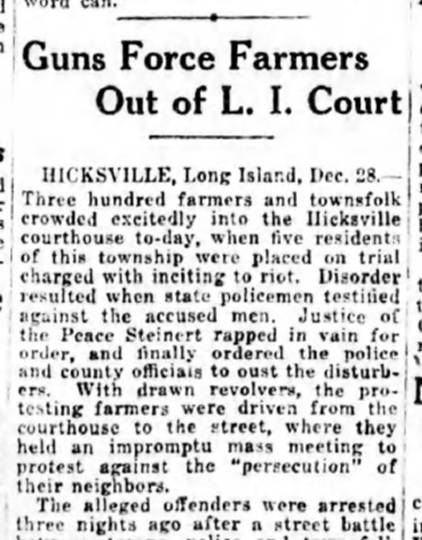
Perhaps shaken by the hubbub, Justice Steinert reserved decision, and he postponed the arraignment for a week, those who had been arrested being "bound over" until then. Comments made at the Court House led to reports that some of the men charged had uttered "disparaging remarks concerning the State of New York, the United States, and the Constitution," and thus might face additional charges of sedition.
On January 4, 1918, the arraignment resumed. According to the Daily Long Island Farmer, the Deputy Sheriffs among those being arraigned had already been stripped of their badges. After hearing all the testimony, Justice Steinert increased the defendants' bail to $2,000. Four "villagers" (presumably not among those already held) who had threatened to lynch the Troopers were scheduled to face a separate hearing. Justice Steinert indicated that Grand Jury indictments were likely, and that the men who had been charged could be imprisoned for up to five years, and fined $500.
In a twist symptomatic of the day's anti-German feelings, the Farmer appended this gratuitous coda to the arraignment story:

Perhaps it felt that the more Germans who were shown to be involved in such activity, the more people could feel vindicated for hating Germans so much.
***
Newspapers reported that on January 19th, the six men who had been charged appeared in County Court in Mineola. The Grand Jury returned indictments against seven men (i.e., testimony had brought to light the actions of one additional man, Daniel Dempsey). The charges seemed less aggressive than those discussed at the time of Judge Steinert's predictions. The men were indicted for unlawful assembly, for rioting, and for refusing to assist in an arrest. Bail was reduced from $2,000 to $500.
Another situation came to light during the Grand Jury's deliberations, one which arose from a factual error in earlier testimony at the Hicksville Court House. One of the Troopers had misidentified the village street on which part of the incident occurred. Afterwards, a newspaper received a letter which falsely alleged that the Trooper who misspoke had privately admitted to perjury. The letter did not identify its author, but for reasons not stated, the newspaper believed it had been written by Hicksville dental surgeon Elwood A. Curtis. He was a brother of one of the men arrested, but he also was a credible, highly respected member of village government. It printed the letter.
The now-public letter was considered libelous. His purported connection to it led to the indictment of Dr. Curtis for criminal libel. His bail was also set at $500.

Brooklyn Daily Eagle
All of those charged entered pleas of not guilty, and their trials - Elwood Curtis was to be tried separately from the others - were scheduled for February. In the interim, they all went free on bail.
***
The trial of the seven accused, finally conducted in mid-March, proved uneventful, and in comparison to the riot and the exciting first attempt at arraignment, it was anticlimactic. After nearly a full week of testimony from "a great many witnesses" (the press neither described their testimony nor identified them), and then four hours of deliberating, the jury rendered a verdict of guilty on a single charge: unlawful assembly. Strangely, the press does not seem to have reported on the disposition of the more salient indictments that had precipitated the trial.
County Judge Lewis J. Smith, notable at the time for his recent work as prosecutor on a high-profile murder case, dealt with the convicted rioters - perhaps one should instead refer to them as "convicted unlawful assemblers" - as follows:
- William Duffy: reprimand; fined $100
- Herman Ofenloch: reprimand; fined $50
- Christian Brendal: reprimand; fined $50
- Charles Van Wickler: reprimand; fined $50
- Osborne Curtis: reprimand; fined $50
- Adolph Lauck, reprimand; fined $25
- Daniel Dempsey: reprimand; sentence suspended

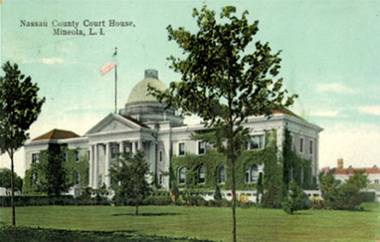
Judge Lewis J. Smith
www.flickr.com/photos/library_of_congress/6266475156/
Nassau County Court House
/www.nycourts.gov/history/legal-history-new-york/courthouses-counties/nassau.html
***
What became of the charge against Dr. Curtis? I have found no reference in any newspaper to his trial for libel, other than its having been scheduled to commence on March 8, 1918 in Mineola. This "exclusive" from the Eagle may provide a clue.

To recap, the Huntington Long Islander had reported on "So-called Rioters," and in return, it had received the libelous letter from "So-called Voters." Apparently, the editors were led to believe that Dr. Curtis was its author, and printed the letter, thereby setting off a sequence of events which brought about the charge of criminal libel.
Obviously, the prosecutor would have needed evidence to counter Elwood Curtis' public denial of responsibility. As can be seen above, the Sergeant's admirable expression of confidence in his Troopers does not imply that there was any such evidence. He must have been well versed in the facts of the case, and yet he did not even hint that any proof of the author's identity had come to light.
If there really was no evidence, then the scheduled trial of Dr. Curtis could not have moved forward. I suspect that it was not held at all. Like the earlier allegations of sedition, and the indictments for rioting and for assaulting a law officer, his indictment for criminal libel seems to have simply evaporated during the two months that followed that tumultuous Christmas Eve.
***
Epilogue
William Duffy
Duffy's rising star seems not to have been dimmed by this incident, for the people in and around Hicksville still trusted him. Within a few years, he became a Vice-President for the National Seed Company, joined the Board of Directors of the Bank of Hicksville, and became Treasurer of the local Knights of Columbus Council. In 1927, he became President of the Long Island National Bank.
He did not forsake farming. When Long Island's farms were being attacked by nematodes (microscopic roundworms, which potentially can destroy entire crops) its farmers needed guidance. Duffy was named to Nassau County's Nematode Committee, which was able to give the farmers access to the best current thinking about the pests' impact, and about possible ways to deal with them.
In 1948, three years before his death, William J. Duffy was chosen to serve as Hicksville's Honorary Mayor during the celebration of the village's tercentenary.
Elwood Curtis
Even as Dr. Curtis faced fallout from his being indicted for criminal libel, he was waging a year-long conflict with the NYS Education Department. Albany had approved a plan to address the overcrowding of Hicksville's lone school, which at the time was operating with split sessions. Curtis felt that the plan - which would build a new school, but in so doing eliminate a village park - was short-sighted. He persuaded the Department to study the situation first-hand, and the subsequent visits by State officials proved persuasive. The plan was rescinded. An alternative approach was devised, one which Dr. Curtis felt would be of significantly greater benefit to Hicksville's students.
Throughout his lifetime, Elwood Curtis continued to serve the Town and the village in various elected and appointed capacities (e.g., he headed the local Draft Board during the second World War). Among all his accomplishments, he is most remembered for winning another hard-fought conflict with Albany: in the 1930s, he led the fight to limit Robert Moses' acquisition of Town beach properties by the State of New York.
***
As far as I know, that's the whole story. If any reader can provide more information or insight about this incident, please email me at
Thank you,
and
Happy New Year!

